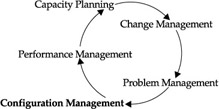Chapter 23: Maintaining Serviceability
| |
Overview
The failure of a switch port, the inoperative disk drive, and the new fabric software all require service to the SAN. Upgrading the NAS storage array, the need to add Ethernet ports, and the installation of the new NAS device all require a change to the storage network configuration. Each of us is familiar with the call at 2:00 A.M. when the production application is down and problems point to the SAN or a suspected NAS device. These are definite problems and require an effective problem identification, tracking, and resolution system.
Servicing is defined by the activities necessary to maintain the hardware and software configurations of computer systems. Storage networks like other infrastructures require servicing. SANs, still being a relatively new technology, are more intensive than most for many reasons, not to mention the diversity of components that make up the configuration. NAS configurations, on the other hand, being somewhat more mature, require very little servicing, although this depends on their application and usage volatility. Regardless of either application of storage networking, each storage infrastructure benefits from a servicing system that provides significant configuration reliability and, subsequently, availability.
Servicing is often driven by problems that occur within the storage network configuration as well as by external problems that affect the performance of the storage network. Secondly, servicing is required for any changes to the configuration meant to fix problems and to enhance or upgrade configuration components. Considering another oft-used work axiom if it aint broke dont fix it the necessity of using a variety of sometimes-compatible hardware and software components brings another dimension to this colloquialism.
From a systems management discipline, the next phase of activities are change management, problem management, and, as its cornerstone as indicated in the following illustration, configuration management. Each plays a pivotal role in the effective servicing of the storage network. Traditional storage management and elements of network management make up many of the elements that are necessary to service the storage network. This requires an integration of traditional configuration management and change management activities. Not to mention the effective development and integration of problem management into the data-center operations and help desk activities.

This chapter discusses the application of these management disciplines to the storage network environment. This includes the complexities of hardware/software compatibility issues that affect SAN configurations and the added value of keeping NAS release levels in sync with each other and the network software. Within the data center, one of the many technical issues to deal with is the integration into other system management disciplines that are already in place. Of these, problem management is one of the most challenging.
The activities to track changes within the storage network are beneficial in order to keep the devices compatible, correlate problem identification, and schedule maintenance activities. However, the benefits of effective change management within the storage network also provide value to external elements within the data-center environment. Integrating yet another level of change into the data center is a challenge. This chapter provides some insight into these potentially volatile situations and offers some guidelines to get things started.
| |
EAN: 2147483647
Pages: 192